Mandevillas, commonly called Rocktrumpet, are one of the easiest climbing plants to care for, with a vibrant show of bright red or white flowers all summer long. Even more attractive than their flower is the simplicity of how to grow Mandevillas.
Most growers use Mandevilla as an annual climber as it’s relatively cheap to buy, and fairly easy to grow, but the waxy leaved climber is actually a frost tender perennial, which can suffer cold shock in temperatures any lower than 10C.
In this guide we’ll lead you through the general growing requirements, propagating Mandevilla tips, and how to store Mandevilla for winter, as while trying not to sing their praises too highly of course.
More...
Mandevillas Plant Details

Rocktrumpet are native to Bolivia and Ecuador, so the closer you are to the equator, the easier they are to grow. These equatorial climbers get their name from their punchy blooms, which blast out from the stems as loud brash trumpets, surrounded by waxy, almost succulent leaves.
The waxy leaves are a great clue to their resilience, as they store water and resist transpiration in drier weather, unlike many tropical plants that seek to expel water from their leaves when they have too much in their roots.
Mandevillas store water in their leaves, which helps protect them from direct sun, in spite of their rich forest green foliage, which acts as a heat sink if left with too direct an exposure.
They are naturally easy-going climbers too, with self-twining vines that grasp onto any structure you give them, a narrow-barred trellis, or even bamboo canes is more than enough to support them, but for me it has to be an obelisk.
Obelisks are top-end climbing structures, and are wasted on annuals, but for the regal Mandevilla, they need support to match.
Best Mandevilla varieties to grow in Australia
1. Mandevilla ‘Alice du Pont’
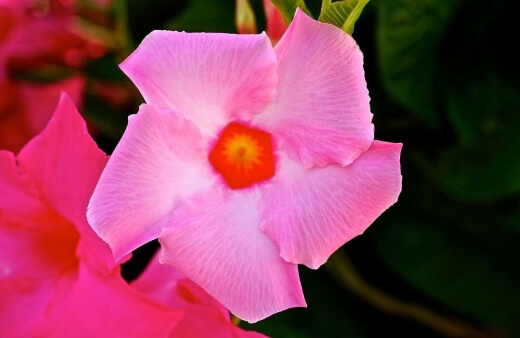
Mandevilla ‘Alice du Pont’ are probably the most impressive Mandevilla you can grow, with intense crimson flowers, reaching up to 20-feet tall even in the coolest parts of Australia.
They need cutting back in winter to grow with the same vigour every year, but with regular fertiliser can easily cover a porch or veranda in a single season.
The shape is less trumpeted than most Mandevillas too, with a more open flower that displays its yellow throat proudly to welcome pollinators and dazzle gardeners and visitors.
2. Mandevilla boliviensis (White Dipladenia)
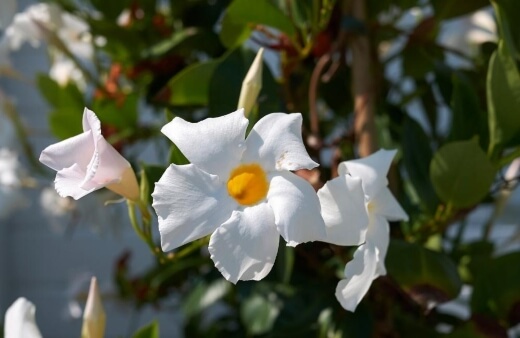
While Mandevilla boliviensis is one of the shortest climbing Mandevillas, it still reaches 10-foot tall in a single growing season. In their first year they can be slow to start while roots establish in their new home.
However, after two or three seasons of growth, they will burst into life every spring, and with a good dose of potassium and phosphorus rich fertilisers they will seriously glow in the garden on a summer evening.
Their petals are more spaced than other varieties too, allowing light to shine through them, so they pick up the best of the afternoon sun if grown on a north-facing pergola.
3. Mandevilla sanderi (Brazilian Jasmine)
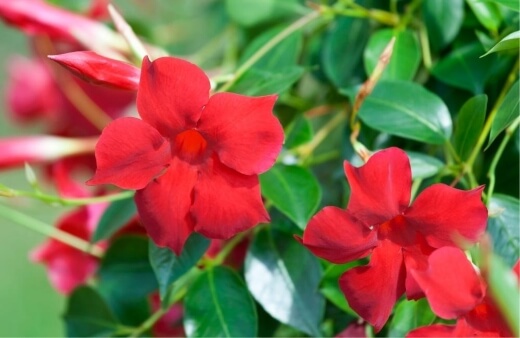
At 15-feet tall, these waxy leaved wonder reach their full height by mid-summer and just keep flowering through to early autumn. They are one of the most reliable Mandevillas you can grow.
Even if you forget about them, they’ll climb and flower without fail. Watering and feeding gives them a good boost though, and rather a fool proof plant, you’ll have a vigorous climber that is utterly full of pastel pink flowers.
How to Grow Mandevillas
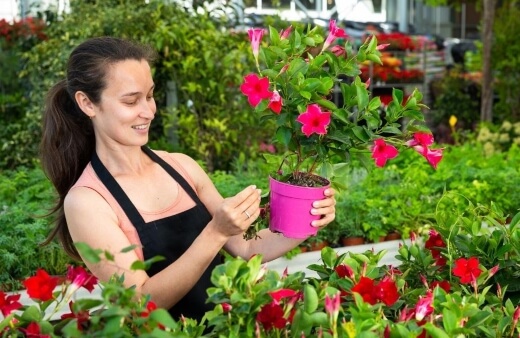
Planting Mandevillas
Mandevillas need root shading if possible, so trailing plants across their base is a great idea. Lobelia require very few nutrients, and Vinca have similarly waxy leaves with contrasting blue and white flowers to offset and highlight the Mandevilla buds that tower over them.
You will find our complete Lobelia grow and care guide quite helpful during this part.
Strangely, this root shading isn’t because they require high water levels, but because they require infrequent watering, and it can reduce the need to water throughout the year.
Rather than keeping them constantly moist, they can be allowed to dry out a little, as long as ground cover plants stop the earth from completely baking at their feet.
Where to Plant Rocktrumpets
Rocktrumpets prefer full sun, but will cope with partial shade. The key is temperature rather than light, but the easiest way to find heat is to find light. These exciting climbers need at least 10C for reliable growth, and prefer summers over 25 for the best floral display.
Because they are so intolerant of Frost, for anywhere other than most northern parts of Australia, they should be planted in containers, and trained up trellis.
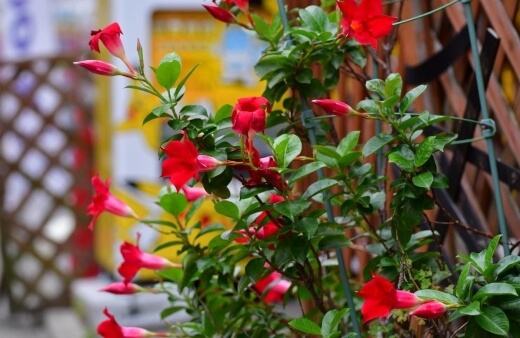
Soil Preference
Mandevillas need good drainage above all else. They hate sitting in water, so for container planting, use a mix of horticultural sand, grit and garden compost (any peat-free multipurpose compost will do the trick).
Compost allows some water retention, and a medium to hold nutrients from fertilisation, while the grit and sand allow excess water to rain freely.
(Make rich quality compost with the help of our worm farm Australian guide.)
If planting directly in the ground, add a few good handfuls of horticultural grit to the base of the planting hole, and surround the plant with the existing garden soil.
Mulch over the top with a good quality peat-free compost to improve nutrients, and your Mandevilla will do just fine. As mentioned above, consider adding a Vinca as a companion plant to help shade the roots.
Caring for Mandevillas
Watering Rocktrumpet
Mandevillas are surprisingly drought tolerant plants. Despite their vigorous waxy growth, they don’t require vast amounts of water to keep them going, and will happily go for a few weeks between watering, even in summer.
For best results though, water Mandevillas every two weeks with about 2-3 litres of water, adding in a good fertiliser to promote flowering. Don’t let them sit in water.
If growing Mandevilla in a pot, ensure the pot has sufficient drainage holes. Mandevillas need as much nutrients as they can get. A good water retentive compost, mixed with horticultural sand and grit is ideal to retain the right amount of moisture, while letting excess easily drain away.

Fertilisers
Phosphorus and potassium are the main ingredients of any good Mandevilla fertiliser. Rocktrumpets don't need much Nitrogen at all, but it can help young plants to establish in their first year.
Every spring, add a high phosphorus and potassium fertiliser in the form of granules, or alternatively, add a fortnightly liquid feed to your watering can.
Both will work through the season, but chose one or the other as double fertilising perennials is just pouring money down the drain as your plants won’t soak it up.
Pruning Mandevilla
Mandevilla are a soft-stemmed climber, and like most perennial climbers of that description will flower on new growth, so the easiest way to create bushy new growth is to regularly prune them in spring to promote new stems, new leaves, and ultimately, more buds.
To give them a kick start and a bushier habit ready for the growing season, cut them back by two-thirds in winter before covering or bringing them indoors for storage. This will promote vigorous new growth in spring.
Be sure to use reliable pruning shears to make clean cuts every time.
How to keep Mandevillas through winter
In the hotter northern regions of Australia, Mandevillas will be fine outdoors all winter, as it's unlikely to see temperatures low enough to kill them. For anywhere south of Cairns, you’ll need to bring Mandevilla indoors for winter, or cut them back and store them in a shed or greenhouse.
If you’ve planted them in the ground, don’t worry, there are two options. One is to cut them back to about a third of their height, and cover them with fleece through winter, but the safer option is to dig them up.
They root very slowly, so digging them out with a garden fork will bring up their entire root ball. Simply place them in a pot and cover with compost to keep the roots warm over winter.
Next year, you can plant the entire pot in the ground to make it easier to lift out at the end of the growing season.
Common Mandevilla Pests and Diseases
Mandevilla are prone to aphids and spider mites like most tropical and equatorial plants, but their care is the same as on any other plant, simply treat them with an organic pesticide like neem oil, or wash them off with a high-pressure hose nozzle.
The issues with Mandevilla are caused by disease rather than pests, and most are a side effect of over-watering.
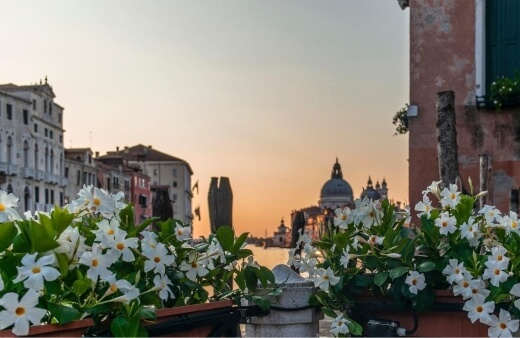
Anthracnose
Signs
Anthracnose in Mandevilla can be devastating to your ornamental climbers, causing rapid die back and even covering large yellow leaf spots all over the plant, usually with the spot’s centre along the midrib of the leaf.
Treatment
Anthracnose is a fungal disease common in many ornamental plants, but particularly problematic in Mandevillas. One the signs appear, a treatment of fungicide every two days to a fortnight should help slow the spread, and even revive the plant.
In addition, any heavily affected growth should be carefully removed and burned to prevent the fungus spreading further. To prevent Anthracnose, make sure the leaves are never directly watered or misted.
They should only ever be watered in the afternoon, directly at their roots. Water splashing on Mandevilla leaves causes the spots, which leads to humidity build ups.
Botrytis Blight
Signs
Botrytis blight, or grey mold is a very common, but easily treatable disease. It spreads via fungal spores in the air, which attach to wet plant materials and spread in high humidity and cool temperatures.
It is most common in late summer when the temperatures begin to drop. Symptoms are wilting foliage, covered with brown leaf tissue surrounded by otherwise healthy green leaves.
If Botrytis sets in before flowering, a grey mold can cover buds, preventing them from opening and rotting them from the outside.
Treatment
To treat Botrytis effectively, neem oil can be sprayed directly on plants to help dry out the fungus, and also prevent it from spreading. As with all fungal infections in mature plants, the fastest cure is to cut off and burn affected areas.
To prevent Botrytis, maintaining good air circulation is key. Better air flow means lower humidity.
Crown Galls
Signs
Crown galls are unsightly growths caused by the bacterial pathogen Agrobacterium tumefaciens. The gall itself is a swollen tissue growth at the base of Mandevilla vines.
As they expand they reduce the plants ability to move water and nutrients up the stems to the foliage and flowers, which completely stops the plant from growing or feeding itself.
If these swollen bases to your plant’s stems are spreading down to the roots it is almost certainly Crown Galls.
Treatment
There is no cure for crown galls, and the bacterial pathogen can spread quickly to other plants. Once you are sure the cause of your plant’s ill health is crown galls, you need to dig up the plant, root and all, and burn the entire thing.
If you can’t burn it, place it immediately in a black bin liner and dispose of it in regular waste as the pathogen easily passes to other plants.
Fusarium Rot
Signs
Fusarium rot on Mandevilla is quite rare, but easily treatable. The first signs are a sudden yellowing or browning of leaves in an even fashion. This is usually contained to one section of vine, but can spread.
The fungus travels down the stems, so will move consecutively down the plant until it reaches a new stem and travels up, or if the stems are in close contact it can move between vines by rubbing together.
Treatment
The treatment of Fusarium rot on Mandevillas is relatively simple, but quite aggressive e. Literally drench the plant in fungicides, spraying from top to bottom every day for at least a week until the fungus has dried up.
Remove affected growth before you start treatment, as the most effective use of neem oil or other organic fungicides is as a preventative rather than a cure.
Mandevilla FAQS

Do Mandevilla need trellis?
Yes, Mandevillas need trellis or support to climb up. In their natural habitat they are self-twining plants that will cling to any support they can find.
They need to climb as their vines need full sun to flower well. Growing them in too condensed a clump will block sun from central vines, so ensuring they have space to spread is essential.
Does Mandevilla come back each year?
Yes, in most of Australia, Mandevillas are perennials, but they are not frost hardy. Even in colder regions, they can be grown in containers and brought indoors, or stored in the garage over winter.
They go completely dormant so don’t require sunlight in winter if you can’t find somewhere warm and bright for them.
Where do Mandevillas grow best?
All Mandevilla varieties prefer full sun, and should be placed somewhere with direct light for at least 6 hours per day. If you’re planting them in the ground, make sure to add grit to the base of the planting hole to aid drainage if your soil is at all water-logged.
Why are my Mandevilla leaves turning yellow?
Mandevillas really don’t like sitting in water. The most common reason their leaves turn yellow is that they are sitting in standing water due to inadequate drainage.
On the other hand, Mandevillas can start showing yellow leaves if they are too dry, but this is usually paired with crisping of the leaves.
Elevating Your Garden with Vibrant Blooms of Mandevilla Flowers
Growing climbers is usually a patient game, sometimes waiting years for roses or Wisteria to reach maturity, but often perennial climbers like Mandevilla can give more impact, much faster with mountainous blooms filling a wall or trellis within a single season.
For me it’s got to be Mandevilla boliviensis with its fast-growing white towers of vines, that cling easily to trellis or wire up the legs of a North facing pergola, and understanding how to grow Mandevillas really isn’t that complicated.
Just a little attention to detail when you first plant them, and an awareness of your own climate is all you need to grow Mandevilla successfully.
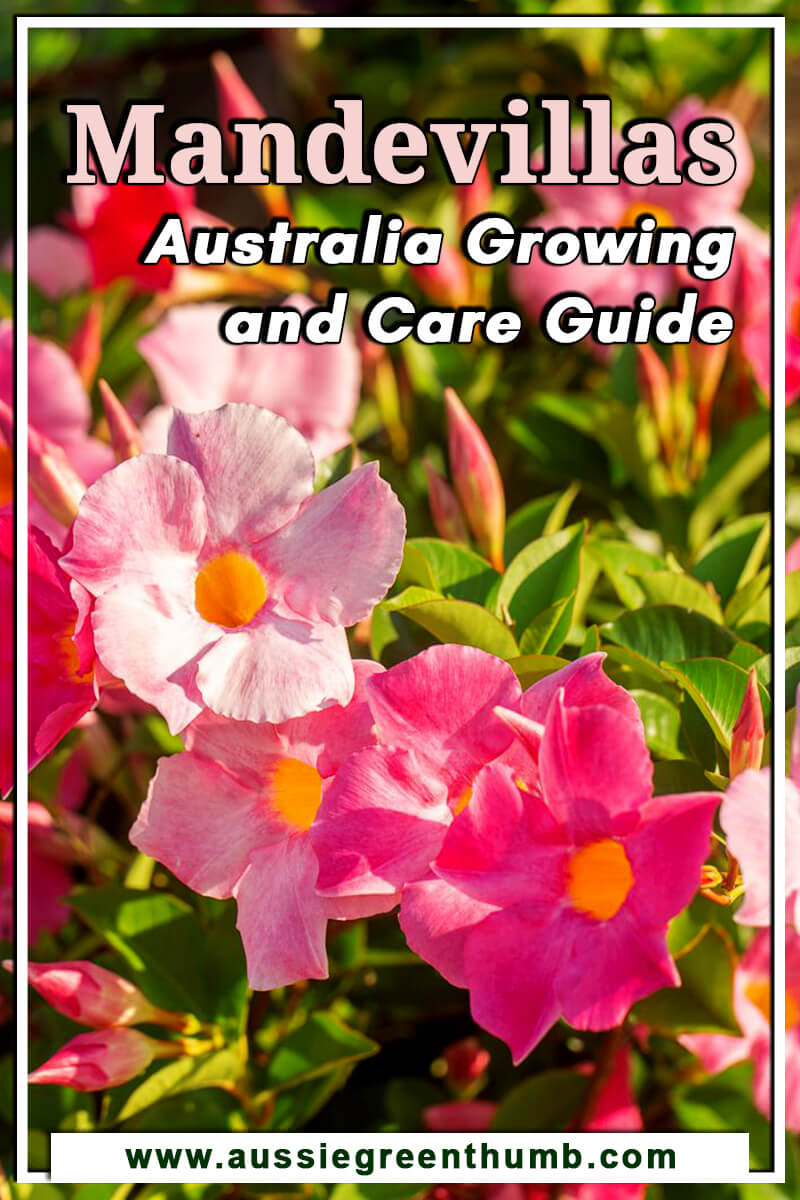
Published on January 13, 2022 by Maisie Blevins
Last Updated on February 12, 2024




